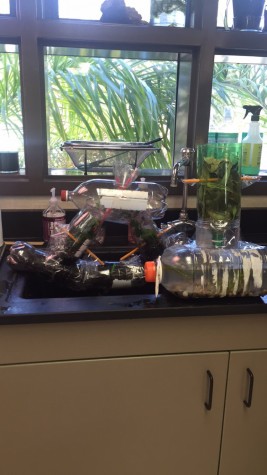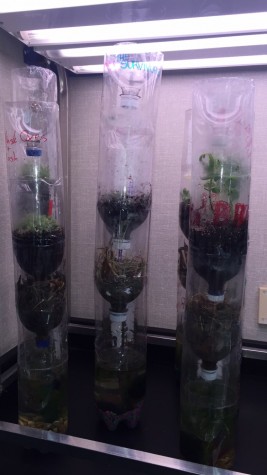By, Brooke Herbes | Writer & Masie Velasquez | Writer
January 15, 2016
Environmental Science is a AP/IB class that not only involves our modern day world and the issues we are facing now but conducts many thought-provoking experiments. One of these is the Ecocolumns, a long, makeshift tube made out of 5 plastic bottles and involve aquatic and terrestrial life. The environmental students have been looking forward to this lab all semester, now it’s here, and the stakes are high to see who’s will survive until May.
What is a terrestrial chamber? That’s the part of the column where the plant/ animals live. What is an aquatic chamber? That’s the portion of the column where the fish lives. What is a decomposition chamber? That’s where nutrients are naturally recycled by microorganisms and bacteria.
 The AP students conducting this experiment had to plan for this, they had to research which plants could live in the space of a 2-3 liter bottle, where small critters could live, as long as they could live off of the food produced by the plant in the terrestrial chamber, and which decomposition materials they had to collect in order to decompose at a good pace. Multiple students told us, “The best spot to get the plants is Plant Depot, and the spot to get your fish is PetSmart.”
The AP students conducting this experiment had to plan for this, they had to research which plants could live in the space of a 2-3 liter bottle, where small critters could live, as long as they could live off of the food produced by the plant in the terrestrial chamber, and which decomposition materials they had to collect in order to decompose at a good pace. Multiple students told us, “The best spot to get the plants is Plant Depot, and the spot to get your fish is PetSmart.”
As we watched the students create their ecocolumns, we noticed it was a very strenuous process. Erica Cornelius told us, “We had to first cut out the tops of the 2 liter bottles, then begin with planting our plant in the terrestrial chamber.” It was vital to overwater the plant in the beginning, and then let it drip so it would not poison the fish in the chamber below. Students were free to choose any type of fish they pleased, we noticed the most popular was a Male Betta. Because who wants an ugly fish when you can get a pretty one? Many lab group also purchased lizards, frogs or toads.
We asked Julia Brandt, “How long do you expect your ecocolumn to survive?” She said, “I think our column should last a long time because it is a self sustaining system,” we also asked her, “How creative did you get, if you did what did you do special?” she responded saying, “Our design is pretty standard, however we added a moss ball to the aquatic chamber to help keep the water clean.” We also asked, “Any animals, if so what type?” Julia told us, “While most people used betta fish, we used a mosquito fish. His name is Darwin. He is very ugly and hard to see but if you look hard enough he is there!”
The purpose of the EcoColumn is to demonstrate how all different parts of nature interact in one ecosystem, while also teaching us certain ways of how animals and plants survive and what factors can influence change in the ecosystem. The main reason to create an EcoColumn is to create three ecosystems ( terrestrial, decomposition, and aquatic) in one column to see the abiotic and biotic factors of living organisms to check if they are able to survive and sustain themselves and from there a comparison will be made, not just inside the classroom but outside of it as well.
These students are trying to make their EcoColumns thrive and survive until May. Each week they will be observing the changes to the mini-environments they created. This lab inspired freshman who had Mrs. Kerr for Biology 2 or 3 years ago to take Environmental Science, and challenge themselves to keep a living system alive in such a confined space. And to all Environmental students, good luck!

Leave a Reply